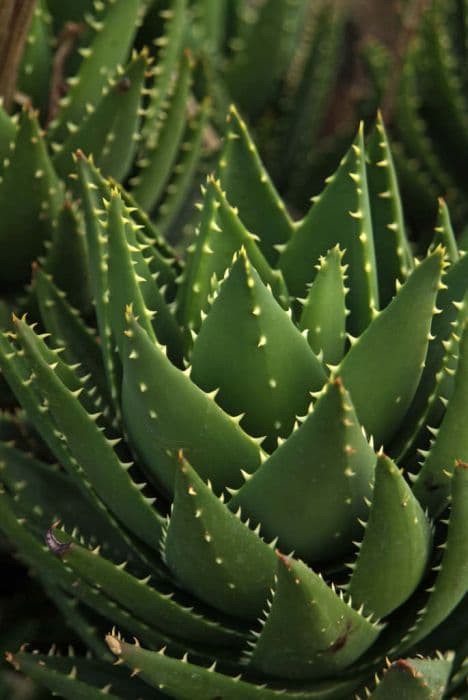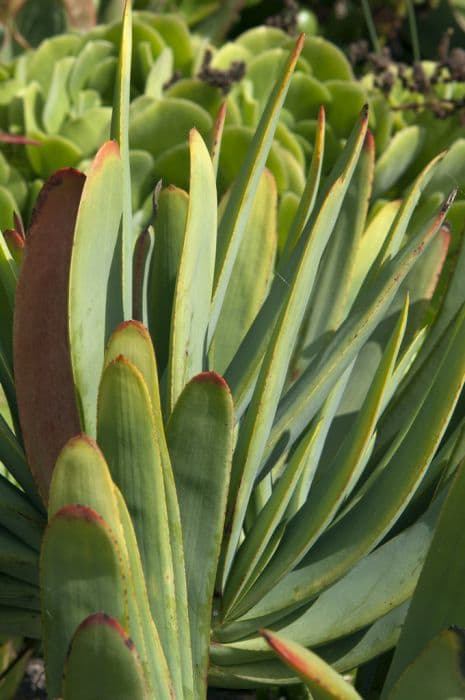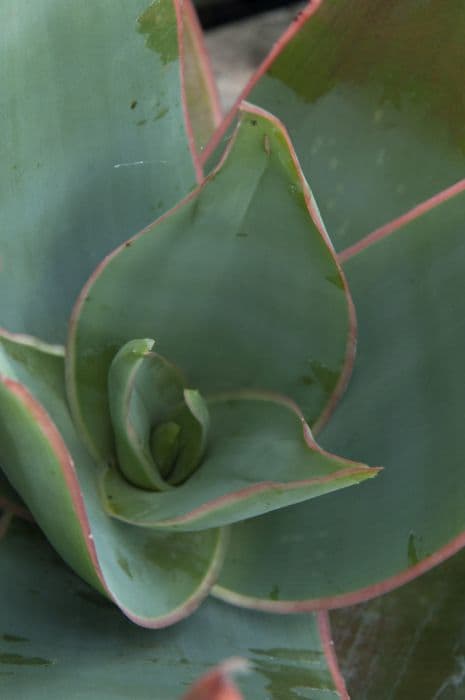Somali Aloe Aloe somaliensis

ABOUT
Aloe somaliensis, commonly known as the Somali aloe, is a distinctive plant with fleshy, triangular leaves that are a rich, green color. The leaves are stacked in a rosette formation and can display a variety of patterns. Often, you might notice the leaves have white speckles spread across them, adding to the plant's intricate appearance. Along the edges of the leaves, there are usually small, tooth-like projections that can be quite sharp to the touch. The Somali aloe typically has leaves that are thick and succulent, containing the gel-like substance that aloes are well known for. When this plant blooms, it produces a flower spike, which is adorned with tubular-shaped flowers. The flowers tend to be a vibrant color, often a shade of orange, red or yellow, making them stand out beautifully against the green of the leaves. The bloom of the Somali aloe adds an additional ornamental value to the plant, making it a popular choice for garden enthusiasts and collectors of succulents. The plant overall has a symmetrical and sculptured appearance, with its aloe-like characteristics, it can lend an exotic and tropical feel to the environment it's placed in.
About this plant
 Names
NamesFamily
Asphodelaceae
Synonyms
Somali Aloe, Dwarf Bottlebrush Aloe
Common names
Aloe somaliensis
 Toxicity
ToxicityTo humans
Somali Aloe, like many Aloe species, can be mildly toxic to humans if ingested. While its topical use is generally considered safe, consumption of the leaves may lead to symptoms such as diarrhea, abdominal cramps, and nausea due to the presence of latex, which is a yellow sap found just under the surface of the leaf. This latex contains anthraquinones, which are known to have a laxative effect. It is suggested to avoid consuming any part of the Somali Aloe to prevent these adverse effects.
To pets
Somali Aloe can be toxic to pets if ingested. In cats and dogs, eating this plant might result in vomiting, lethargy, diarrhea, and in rare cases, tremors. The toxic components are saponins and anthraquinones, which are found in the plant's latex. It is advised to keep Somali Aloe out of reach of pets to avoid gastrointestinal upset and potential health complications.
 Characteristics
CharacteristicsLife cycle
Perennials
Foliage type
Evergreen
Color of leaves
Green
Flower color
Orange
Height
1-2 feet (30-60 cm)
Spread
1-2 feet (30-60 cm)
Plant type
Succulent
Hardiness zones
10
Native area
Somalia
Benefits
 General Benefits
General Benefits- Low Maintenance: Aloe somaliensis, commonly known as Somali Aloe, is a hardy succulent that requires minimal care, making it ideal for busy plant lovers or those new to gardening.
- Drought Tolerant: This plant is extremely drought-tolerant, which means it can survive long periods without water, conserving resources and suiting water-restricted areas.
- Attractive Appearance: With its distinctive rosettes of spiky, variegated leaves, the Somali Aloe adds an exotic and sculptural element to gardens or indoor spaces.
- Easy Propagation: This aloe species propagates readily from offsets, allowing gardeners to easily grow more plants and share with friends and family.
- Resistant to Pests: The Somali Aloe is generally resistant to pests, minimizing the need for chemical pest control measures.
- Compact Size: Its compact size makes it convenient for cultivation in containers, suitable for limited spaces such as balconies, patios, or windowsills.
- Year-Round Interest: As a perennial, the Somali Aloe offers visual interest throughout the year, and its flowers can attract pollinators such as bees when it blooms outdoors.
- Soil Adaptability: It can thrive in a range of soil types, provided they are well-draining, making it versatile for different garden settings.
 Medical Properties
Medical PropertiesThis plant is not used for medical purposes.
 Air-purifying Qualities
Air-purifying QualitiesThis plant is not specifically known for air purifying qualities.
 Other Uses
Other Uses- Aloe somaliensis, commonly known as Somali Aloe, can be used as an ornamental plant in rock gardens or succulent collections due to its distinctive and attractive foliage.
- The sap of Somali Aloe can be used as a natural adhesive in small scale or emergency situations, such as sealing small envelopes or paper crafts.
- Extracts from the Somali Aloe can be utilized in natural dye-making processes to achieve subtle green or yellow hues for fabrics and artworks.
- When dried and crushed, the leaves of the Somali Aloe can be used to create a natural insect repellent for warding off certain pests in the garden.
- The Somali Aloe's robust root system can be useful for soil stabilization in areas prone to erosion, due to its drought-resistant nature.
- The fibrous material of the plant can be used in traditional handcrafts, such as making twine or rope in small quantities.
- The thick leaves of the Somali Aloe can serve as insulation material in miniature DIY projects, exploiting their thermal retention properties.
- With proper treatment and cutting, the leaves of the Somali Aloe can be fashioned into impromptu bookmarks that are both functional and decorative.
- When the flowers of the Somali Aloe are in bloom, they can attract pollinators such as bees and butterflies, supporting the local ecosystem.
- As a subject in photography, the unique structure and color of the Somali Aloe can provide a focal point in desert-themed compositions and artistic projects.
Interesting Facts
 Feng Shui
Feng ShuiThe plant Aloe somaliensis is not used in Feng Shui practice.
 Zodiac Sign Compitability
Zodiac Sign CompitabilitySomali Aloe is not used in astrology practice.
 Plant Symbolism
Plant Symbolism- Healing: Aloe Vera, related to Aloe somaliensis, is widely known for its medicinal properties, especially in skin care and wound healing. The association with healing is often extended to Aloe somaliensis.
- Protection: Since many species of Aloe are used in folk medicine to ward off bad luck and evil spirits, Aloe somaliensis may also symbolize protection and safekeeping.
- Endurance: Aloe plants are succulents that can survive in harsh, arid environments, as such, Aloe somaliensis symbolizes endurance and the ability to thrive in difficult conditions.
- Persistence: The persistent nature of the Aloe, with its capacity to store water, allows it to symbolize resilience and the persistence of life.
- Beauty: With its striking and unique foliage, Aloe somaliensis can symbolize natural beauty and the appreciation of unique forms in nature.
 Water
WaterSomali Aloe requires careful watering to avoid overhydration, as it’s adapted to dry climates. Water the plant deeply but infrequently, allowing the soil to dry out completely between waterings. Typically, watering every 2-3 weeks should be sufficient, but this can vary based on your local climate and indoor conditions. Provide approximately 8-10 ounces of water for a medium-sized pot each time you water. During the winter months, reduce the frequency further as the plant enters a period of dormancy.
 Light
LightSomali Aloe thrives in bright, indirect sunlight. The best spot for this succulent is near a south or west-facing window where it will receive plenty of light without the harsh direct rays of the sun that can scorch its leaves. If grown outdoors, it needs a sunny spot with some partial shade during the hottest part of the day.
 Temperature
TemperatureSomali Aloe prefers a warm environment with temperatures ranging from 60 to 85 degrees Fahrenheit. It can tolerate a minimum temperature of about 50 degrees Fahrenheit, but prolonged exposure to cold will damage the plant. Ideally, maintain a consistent temperature around the higher end of its preferred range for optimal growth.
 Pruning
PruningPruning Somali Aloe is typically done to remove damaged or dead leaves and to maintain its desired shape. Use sharp, clean shears and cut away these parts close to the base without harming the main rosette. Pruning is best done in the spring or early summer, but only as needed and not on a regular schedule.
 Cleaning
CleaningAs needed
 Soil
SoilSomali Aloe requires a well-draining cactus or succulent mix with additional perlite or pumice to enhance drainage. The best soil pH for the Somali Aloe should be slightly acidic to neutral, around 6.0 to 7.5.
 Repotting
RepottingSomali Aloe should be repotted every two to three years or when it has outgrown its pot or the soil has degraded, ensuring fresh soil and room for growth.
 Humidity & Misting
Humidity & MistingSomali Aloe thrives in low to moderate humidity conditions and does not require high humidity levels, making it well-suited for typical indoor environments.
 Suitable locations
Suitable locationsIndoor
Place Somali Aloe in bright, indirect light inside.
Outdoor
Plant Somali Aloe in bright sunlight, protect from frost.
Hardiness zone
10-12 USDA
 Life cycle
Life cycleAloe somaliensis, commonly known as Somali Aloe, starts its life cycle with seed germination, which is dependent on warm temperatures and occasional watering. After germination, the seedlings establish themselves with the formation of roots and small rosettes of fleshy leaves characteristic of the Aloe genus. As the plant matures, it enters a vegetative stage where it continues to grow in size and may produce offsets, also known as pups, at the base of the parent plant. These pups can be separated and planted to propagate new plants. When the plant reaches maturity, which can take several years, it develops an inflorescence — a tall flower spike with tubular red or orange flowers that attract pollinators like bees and birds. Following pollination, the plant sets seeds within capsules that, once dry, release seeds to start the cycle anew.
 Propogation
PropogationPropogation time
Spring-Summer
Aloe somaliensis, commonly known as Somali Aloe, is typically propagated through offsets, which are small shoots or pups that emerge from the base of the mother plant. To propagate Somali Aloe using offsets, wait until the pups are a few inches tall and have their own roots. Carefully remove them from the parent plant by gently teasing them apart, ensuring that each offset has a section of roots attached. Allow the offsets to dry for a day or two until the cut surface forms a callus. This helps to prevent rotting when planted. Plant the offsets in a well-draining cactus or succulent potting mix, and water them sparingly until they are established. The best time to propagate is during the warmer months when the plant is actively growing, typically in spring or early summer.









